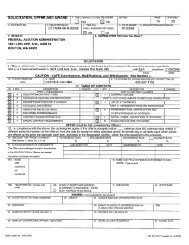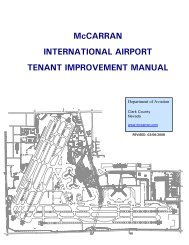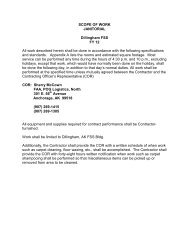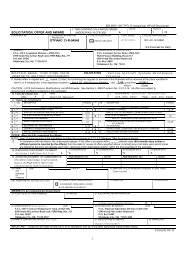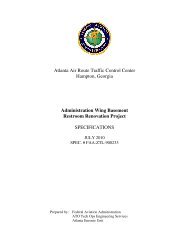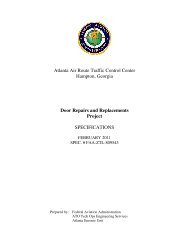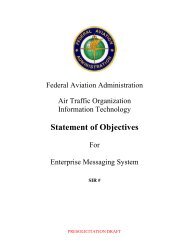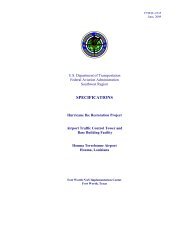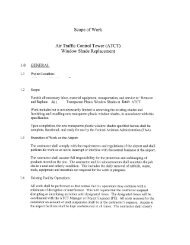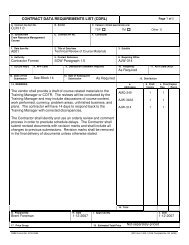Risk Management Plan - FAACO - Federal Aviation Administration ...
Risk Management Plan - FAACO - Federal Aviation Administration ...
Risk Management Plan - FAACO - Federal Aviation Administration ...
You also want an ePaper? Increase the reach of your titles
YUMPU automatically turns print PDFs into web optimized ePapers that Google loves.
IV. The Alternate Standard<br />
(a) Scope and Application. This standard applies to<br />
all <strong>Federal</strong>ly owned or operated ATCTs. It sets forth<br />
minimum requirements essential to providing a safe means of<br />
exit in case of fire and other emergencies.<br />
(b) Definitions.<br />
“Authorized Person” means an employee who has been<br />
specifically assigned by the employer to assure compliance<br />
with this standard.<br />
“Base Building” means a structure including links and<br />
vestibules which connects with the ATCT and which may house<br />
administrative personnel, Terminal Radar Approach Control<br />
(TRACON) or passenger-related functions.<br />
“Cab” means the primary operating space in the ATCT<br />
situated at a desired elevation above ground level and<br />
physically oriented relative to the primary runways, so as<br />
to obtain the best unobstructed view of the airport aircraft<br />
primary movement areas (taxiways, runways, and flight<br />
approaches and departures).<br />
“Class A Finish” means any material classified at<br />
twenty-five (25) or less on the flame spread test scale and<br />
450 or less on the smoke test scale described in 6-5.3.1 of<br />
NFPA-101.<br />
“Class B Finish” means any material classified at more<br />
than twenty-five but not more than seventy-five on the flame<br />
spread test and 450 or less on the smoke test scale<br />
described in 6-5.3.1 of the NFPA-101.<br />
“Emergency Action <strong>Plan</strong>” means a plan for a workplace,<br />
or parts thereof, describing what procedures the employer<br />
and employees must take to ensure employee safety from fire<br />
or other emergencies.<br />
“Emergency Exit Route” means the route that employees<br />
are directed to follow in the event they are required to<br />
evacuate the workplace or seek a designated refuge area.<br />
“Exit” means a portion of a means of egress which is<br />
separated from all other spaces of the structure by<br />
14



